Measuring Outcomes
The Department's success is determined by the extent to which the departmental outcomes of protecting the public and reducing re-offending are achieved, which in turn contribute to the justice sector end outcome of safer communities and, through this, to the Government's key goals.
Attribution and Accountability
Measurement of progress can be intrinsically difficult because outcomes are often influenced by factors beyond an individual agency'control. The nature of the measures developed for each outcome means that some measures are better suited to providing information on the impact of the Department' interventions, as opposed to those external factors.
The Department' interventions seek to change the behaviour of the persons who come under its care and control. The likelihood of individual offenders re-offending is assumed to be based, in part, on relatively stable (though potentially changeable) personal and social characteristics. Personal characteristics include violence propensity, substance dependence, attitudes and values supportive of criminality, as well as deficits in educational and occupational skills. Social characteristics include lack of social supports, homelessness and lack of employment. The Department therefore offers a range of services that are intended to:
- reduce the severity of antisocial traits
- build socially adaptive skills and abilities
- resolve or mitigate environmental obstacles faced by offenders.
In addition to attempting to encourage personal change, and providing support and assistance to offenders, the Department also provides monitoring of and direction to those offenders subject to community sentences and orders. In doing so, the Department endeavours to prevent offenders from relapsing into undesirable patterns of behaviour, as well as enabling preemptive actions to be taken when risks become elevated.
It is recognised, however, that the Department cannot completely control the outcomes experienced by offenders. Limiting factors include:
- for many offenders, the sentence imposed is too brief in duration to allow meaningful engagement with services
- many offenders are not motivated to address the personal and social issues that underlie their offending risk (and there are seldom reasonable or effective ways to compel them to do so)
- when in the community, the location and behaviour of offenders cannot be continuously monitored, except in certain circumstances such as the first 12 months of an extended supervision order
- events and circumstances well beyond the control of the Department, which may dramatically and abruptly alter an offender's isk of re-offending, can (and frequently do) occur.
Fundamentally, criminality is understood to be a relatively robust and enduring personal characteristic in adult offenders. Even when exposed to the most sophisticated and intensive rehabilitative and reintegrative services, a substantial proportion of offenders will nevertheless go on to re-offend. The Department endeavours, through its suite of interventions, to reduce this proportion.
Further, in relation to the goal of safer communities generally, the Department's contribution is in reducing risk associated with offenders who have already come under its care and control. The Department can exert no influence that might prevent offending by those who have not previously been under its auspices, or to reduce the number of young offenders entering the criminal justice system for the first time.
Linking Outcomes to Outputs
The delivery of the Department's outputs directly contributes to the achievement of its outcomes. These linkages are demonstrated in the diagram on pages 24 to 25.
Departmental Contribution
To demonstrate success, processes must be in place to measure achievement. Progress made towards achieving the objectives and outcomes outlined in the Department's 2004/05 Statement of Intent are reported in this annual report. This annual report details the work the Department has completed with respect to initiatives associated with the four themes of its Strategic Business Plan 2003-2008, and the priority areas within those themes. It also reports on the performance measures and standards associated with the output classes.
The Department has developed a set of measures, based on data collected through its offender management processes and similar information obtained from corrections agencies in other countries, which enable comparisons to be made. These measures provide a good starting point for assessing the Department's performance and will be enhanced over time in conjunction with other justice sector agencies.
Linking Outcomes to Outputs
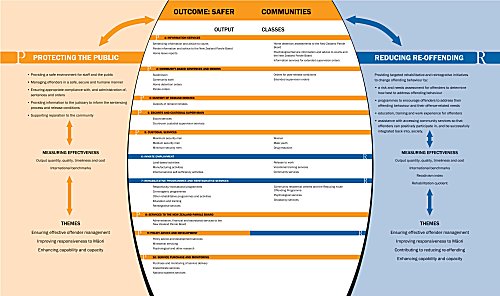
Click here to view a large version of this image (jpg: 501KB)
The Department also monitors the application of specific offender management processes to ensure they are properly and consistently applied. Individual processes are also reviewed periodically to ensure that they remain effective, and are amended where necessary. This activity is intended to support a process of continuous improvement while ensuring the integrity of the information used by the Department for assessing its contribution to outcomes.
Other Linkages
The measures described for Theme 1, ensuring effective offender management, and Theme 3, contributing to reducing re-offending, also provide information for Theme 2, improving responsiveness to Maori, because the data can be analysed by ethnicity. Theme 4 encompasses strategies and initiatives to enhance overall capability and capacity. These include targets for developing the capability of staff and managers and enhancing responsiveness to workplace diversity.
The Department has measures to monitor progress in these areas and will be developing them further. Other targets include the processes in place to develop new prisons, the programme for facilities maintenance and continuous improvement of systems.
International Benchmarking
The Department has developed close working relationships, and exchanges information, with a number of overseas jurisdictions, such as Australia, Canada, England and Wales, and Scotland.
These relationships are facilitated through the Department's membership of the International Roundtable for Correctional Excellence, the International Corrections and Prisons Association and the Australasian Corrective Services Administrators' Conference and National Corrections Advisory Group. This information has been used to develop benchmarks comparing performance across a range of indicators, including prisoner-to-staff ratios, costs of securing prisoners and occupancy statistics. This data is important because the Department is not able to compare performance in its core offender management functions against other New Zealand organisations.
Benchmarking also supports strategic advancement because it provides a means by which quality improvement can be identified and effected. Work continues on developing new measures and refining existing measures to ensure comparability. Current benchmarking data is included in the following sections of this annual report, and is published each year in international reports, including the Australasian National Corrections Advisory Group Comparative Analysis Report.
In making these comparisons, the Department assesses the comparability of the data in question. Where the jurisdictions have similar business operations, definitions and counting rules, there is high comparability, allowing benchmarking with no adjustments. Where the jurisdictions have similar business operations, but minor inconsistencies in definitions and counting rules, there is medium comparability, providing a reasonable benchmark comparison, although one that may require small adjustments to data and counting. Where the jurisdictions again have similar operations but different definitions and counting rules, adjustments would be required before true benchmark comparisons could be made, and therefore comparability is low. Such adjustments have not been made to the data reported in this annual report.
The Department's use of international benchmarking continues to develop. The data available still stands largely alone and further analysis is required before informed comparison may be made between New Zealand and its benchmark jurisdictions. Full comparisons need to take account of a range of variables. For example, Scotland, with lower costs than New Zealand, also has lower prisonerto- staff ratios, a higher occupancy rate and higher assault rates, but lower death rates and lower rates of escapes, while positive drug tests are at similar levels. From this, it is not yet possible to draw firm conclusions about the relative performance of the New Zealand and Scottish prison systems. Some observations, however, are made in the commentary accompanying the tables on the following pages.
Protecting the Public
The Departmental outcome of protecting the public is primarily attained by the strategies and initiatives outlined in Theme 1 of the Strategic Business Plan 2003-2008. Progress towards the achievement of the outcome is measured through analysis of data collected across a range of quality and effectiveness measures designed to ensure offenders are being managed in a safe, secure and humane manner. These include measuring and monitoring:
- compliance with, and the administration of, sentences and orders
- the number of escapes that occur from prisons and while under escort or supervision
- the number and severity of incidents, including deaths in custody.
A number of these measures are included in the statement of service performance for output classes 2 to 5 in Part 2. Other measures are included in the Department's performance monitoring framework or provided from internationally benchmarked data.
The graphs on the following pages illustrate the significant progress that has been made in recent years towards improving the Department's performance in a number of key areas. The information is also presented (where relevant) in comparison with the Department's international benchmark jurisdictions (as highlighted in the previous sub-section).
The following table details the specific indicators included within this section.
Table 7: Specific Performance Indicators
|
Indicator type |
Indicator |
|
Efficiency |
Cost Per Prisoner Per Day - New Zealand |
|
Cost Per Prisoner Per Day - International Comparison |
|
|
Prisoner/Frontline Staff Ratio - International Comparison |
|
|
Prisoner/Total Staff Ratio - International Comparison |
|
|
Occupancy - New Zealand |
|
|
Occupancy - International Comparison |
|
|
Quality |
Prisoner/Prisoner Assault (Serious) - New Zealand |
|
Prisoner/Prisoner Assault (Serious) - International Comparison |
|
|
Prisoner/Staff Assault (Serious) - New Zealand |
|
|
Prisoner/Staff Assault (Serious) - International Comparison |
|
|
Unnatural Deaths in Custody - New Zealand |
|
|
Unnatural Deaths in Custody - International Comparison |
|
|
Suicides in Custody - New Zealand |
|
|
Suicides in Custody - International Comparison |
|
|
Breakout Escapes - New Zealand |
|
|
Breakout Escapes - International Comparison |
|
|
General Random Drug Tests - International Comparison |
|
|
Other indicators |
Imprisonment Rate - International Comparison |
Figure 1: Cost Per Prisoner Per Day - New Zealand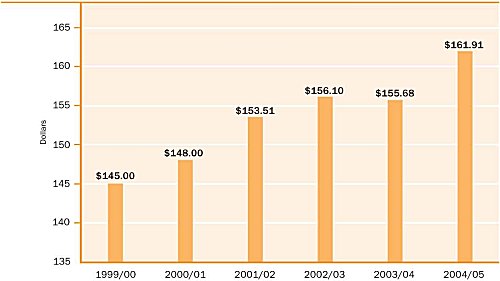
Cost Per Prisoner Per Day
One component in determining the performance of the corrections system is an assessment of the basis of the costs of accommodating a prisoner.
International comparisons of costs between jurisdictions are based on the average daily cost per prisoner using the Economist Annual Comparison Index. Despite a slight trend of increasing costs in New Zealand prisons, New Zealand ranks in the mid-range of the benchmarked jurisdictions.
Figure 2: Cost Per Prisoner Per Day - International Comparison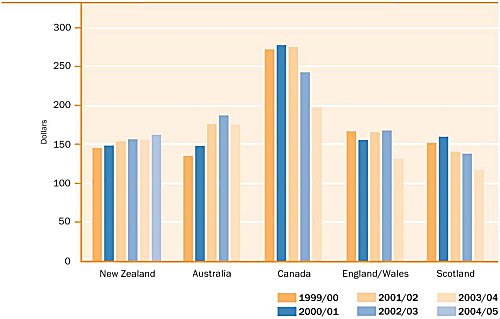
Figure 3: Prisoner/Frontline Staff Ratio - International Comparison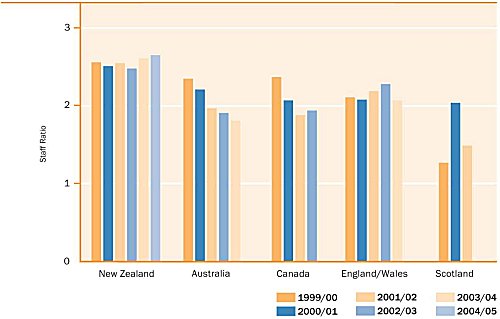
Prisoner/Frontline Staff Ratio
The ratio of prisoners to full-time equivalent (FTE) frontline staff identifies the number of prisoners for each staff member and thus highlights the level of staff supervision available. Figure 3 compares the ratio of the average number of prisoners per annum to FTE frontline staff at the reporting date, across jurisdictions. The New Zealand data excludes prisoners accommodated in the privately managed Auckland Central Remand Prison.
New Zealand has the highest number of prisoners to each frontline staff member (a five-year rolling average ratio of 2.5 from 1999/00 to 2003/04) of all the jurisdictions since 1999/00. Scotland had the lowest number (a three-year rolling average ratio of 1.6 from 1999/00 to 2001/02) but has not reported on this measure in the last two years.
Figure 4: Prisoner/Total Staff Ratio - International Comparison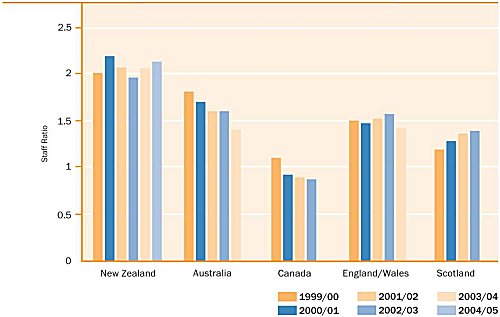
Prisoner/Total Staff Ratio
New Zealand's ratio of prisoners to total staff exceeds that of the other international jurisdictions. In New Zealand there has been an average of two prisoners to one staff member over the period from 1999/00 to 2003/04.
Figure 5: Occupancy - New Zealand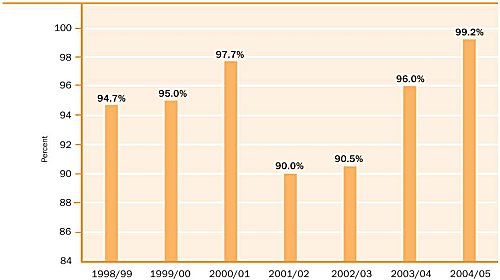
Figure 6: Occupancy - International Comparison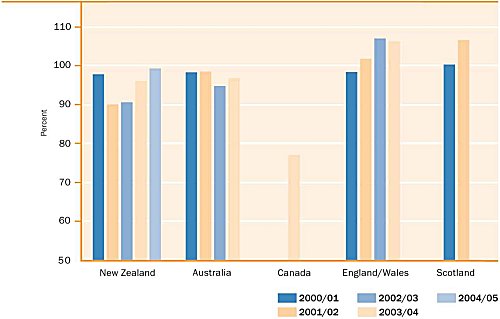
Note: Data not available for Canada 2000/01, 2001/02 and 2003/04 or Scotland 2002/03 and 2003/04.
Occupancy
Occupancy is based on the average number of available (permanent) prison beds and the average prison population for the year.
The optimum rate of prison utilisation is between 85 and 95 percent, which allows facilities to accommodate the transfer of prisoners, provide for special purpose accommodation (for example, protection units), provide separate facilities for males and females and for different security levels, and facilitates the management of shortterm fluctuations in prisoner numbers. New Zealand's occupancy rate will fluctuate over time, as new prison facilities are developed to cater for the increases in prisoner numbers. Average occupancy for the 2004/05 year was 99 percent although for much of the year the prison system was operating at full capacity with court and police cells used to accommodate prisoners.
Of the jurisdictions that provided data in 2003/04, none fell within the preferred range of 85 to 95 percent of design capacity for total prisoners. The comparability of the New Zealand data with the other jurisdictions is assessed as being medium-to-low.
Figure 7: Prisoner/Prisoner Assaults (Serious) - New Zealand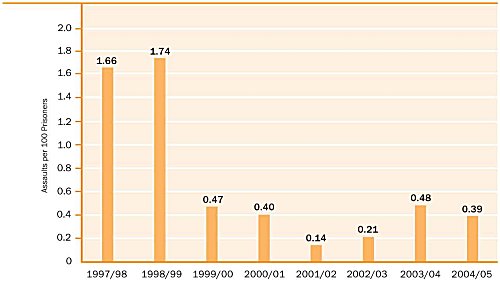
Figure 8: Prisoner/Prisoner Assailt (Serious) - International Comparison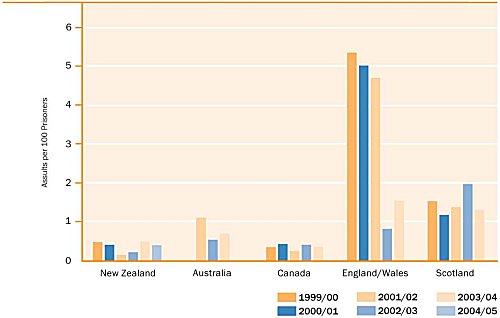
Note: Data not available for Australia 1999/00 and 2000/01.
Prisoner/Prisoner Assault (Serious)
A serious assault is defined as one where the victim requires overnight hospitalisation or ongoing medical intervention. Figures 7 and 8 show the number of serious prisoner/prisoner assaults per 100 prisoners.
There was a steep decline in the number of serious assaults reported in New Zealand prisons between 1998 and 2002. That trend has changed slightly since 2002, but the results are still well below the rates reported in earlier years. The rate of 0.39 for 2004/05 represents a total of 18 serious assaults by prisoners on prisoners, and is a decrease of 40 percent on the result for the 2003/04 financial year. This represents a very favourable result despite the considerable operational pressures from the continuing high prison population levels.
Internationally, in 2003/04, New Zealand had a rate of serious assaults significantly lower than Scotland, Australia and England/Wales. The comparability of the New Zealand data is, however, low with Australia and is not directly comparable with the other jurisdictions because of different counting rules.
Figure 9: Prisoner/Staff Assaults (Serious) - New Zealand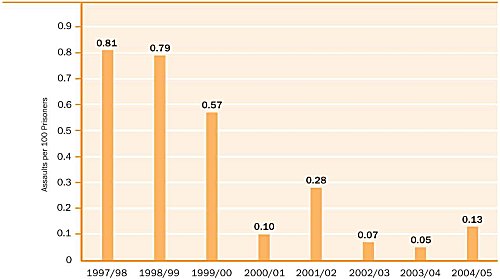
Figure 10: Prisoner/Staff Assaults (Serious) - International Comparison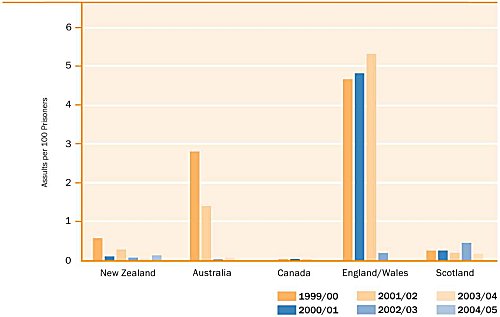
Note: Canada???s reported rate for 2002/03 and 2003/04 was nil.
Prisoner/Staff Assaults (Serious)
Serious assaults by prisoners on staff are those where the victim requires overnight hospitalisation or ongoing medical intervention. The rate of serious assaults (prisoner/staff) is reported per 100 prisoners.
There were nine serious assaults on staff in 2004/05, and the overall trend continues to be downward. This represents a very favourable result despite the considerable operational pressures from the continuing high prison population levels.
New Zealand's low rate of serious prisoner/staff assaults is consistent with the other jurisdictions. England/Wales has not provided data for 2003/04, however, its serious assault rate reduced dramatically in the 2002/03 year. It is not apparent whether this is a result of improved prisoner management regimes or reporting/definitional issues. The comparability of this data is assessed as low.
Figure 11: Unnatural Deaths in Custody - New Zealand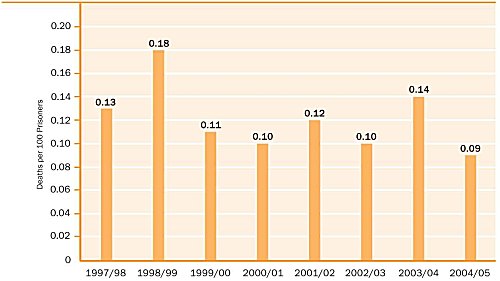
Figure 12: Unnatural Deaths in Custody - International Comparison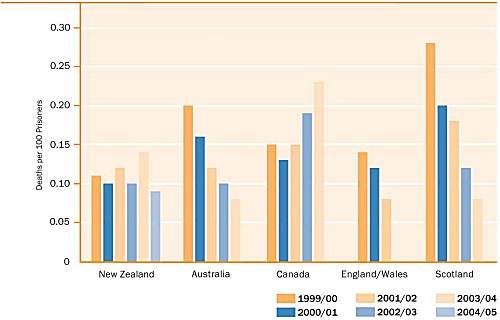
Note: Data not available for England/Wales 2002/03 and 2003/04.
Deaths in Custody
The corrections system has to deal with a high proportion of people with a propensity to self-harm in prison. Deaths in custody are regrettable and are a serious matter subject to independent investigation.
Unnatural Deaths in Custody
Unnatural deaths include suicides, homicides, deaths by drug overdose and deaths by accident. The majority of unnatural deaths in prisons are suicides.
Recent trends in this area in the New Zealand corrections system remain positive. In 2004/05, there were six unnatural deaths in prison (0.09 per 100 prisoners), which represents a decrease of 33 percent on the result for the 2003/04 financial year.
The rate of unnatural deaths in New Zealand remains below that of Canada, however, it has increased above that of Australia and Scotland. England/Wales have not supplied data on this measure for the last two years. The comparability of the New Zealand data is high with all the other jurisdictions.
Figure 13: Suicides in Custody - New Zealand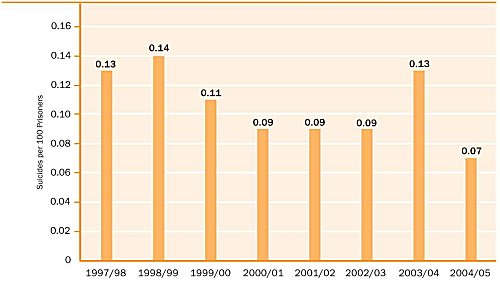
Figure 14: Suicides in Custody - International Comparison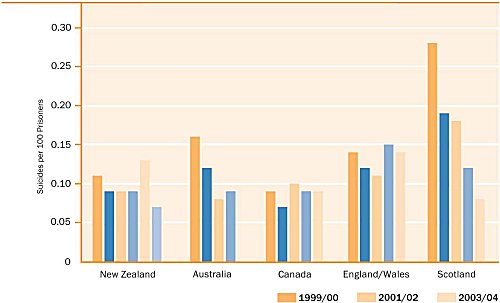
Note: Data not available for Australia 2003/04.
Suicides in Custody
Prisoner suicide reduction continues to be a key priority for the Department. Figure 13 reports the trend in the number of suicides per 100 prisoners.
There were a total of five suicides in 2004/05, two remand prisoners and three sentenced prisoners. The total numbers of suicides in 2004/05 (0.07 per 100 prisoners) represents a decrease of 44 percent on the result for 2003/04, continuing the overall downward trend since 1998/99.
New Zealand's suicide rate has historically been lower than its international benchmark jurisdictions, apart from Canada, where prisoners sentenced to less than two years are not included in the federal statistics.
Figure 15: Breakout Escapes - New Zealand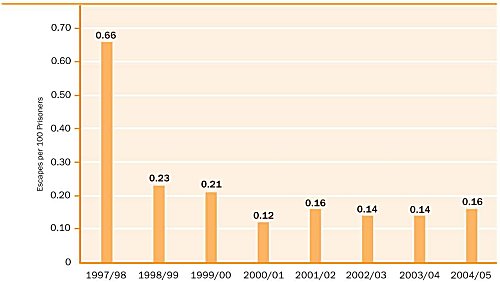
Figure 16: Breakout Escapes - International Comparison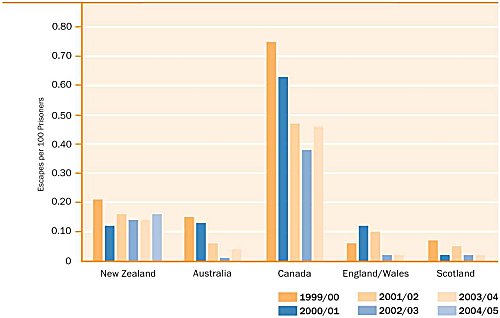
Escapes from Prison
The total number of prisoner escapes in New Zealand against all security classifications in 2004/05 was 19, against an expected performance standard in 2004/05 of 40 escapes.
Figure 15 shows the trend in breakout escapes per 100 prisoners. A breakout escape is one where a prisoner has breached security measures and has physically left the area contained by the outermost perimeter security fence, or, if there is no such fence, prison buildings, police cell, court complex or other place of custodial control.
Of the 19 escapes for 2004/05, there was a total of 11 breakout escapes. Six of the breakout escapes were by prisoners being held in court cells.
The comparability of New Zealand data on breakout escapes is medium with Canada and Scotland, but low with Australia and England/Wales. Canadian data excludes prisoners serving sentences of less than two years, who are not accommodated in federal prisons.
Figure 17: General Random Drug Tests Returning a Positice Result - International Comparison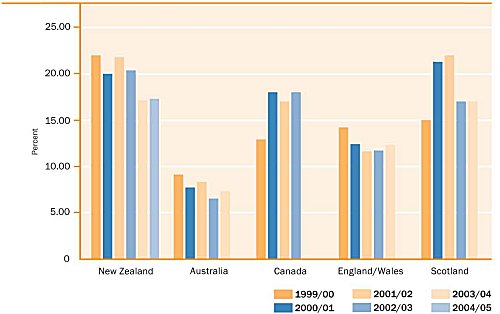
Drug and Alcohol Use by Offenders
In November 2004, the Department introduced its Strategy to Reduce Drug and Alcohol Use by Offenders 2005-2008. This strategy, the third to be released since 1998, builds on the progress achieved under the previous two strategies and outlines directions and initiatives for the 2005-2008 period and beyond. The primary point of difference from previous strategies is that the current strategy extends its focus, as much as practicable, beyond prisons to offenders serving community-based sentences.
The strategy also has an increased focus on what works to reduce drug and alcohol use by Maori offenders. A number of projects, outside the specific scope of the strategy, are being undertaken to improve the involvement of whanau, hapu, iwi and Maori providers in Corrections' work with offenders, but which will be relevant to future directions in reducing Maori offender drug use and re-offending. These projects include investigating the development of programmes for whanau that sit within or parallel to offender programmes, and reviewing rehabilitation programmes (such as the 100-hour substance abuse programme) with the view to increasing whanau involvement.
The strategy recognises that a large proportion of prisoners have drug and alcohol problems. These problems are often a significant factor in their offending behaviours. Drug use in prison perpetuates the dependency problems and the illegal lifestyles of prisoners. It also creates problems for their relatives and friends (such as the pressure to supply drugs) and for prison staff in the management and rehabilitation of prisoners.
The Department's drug strategy is designed around three key objectives:
- enhancing efforts to reduce the supply of drugs to offenders
- strengthening efforts to reduce offenders' demand for drugs
- increasing attention on reducing the harm caused by drugs.
The strategy is supported by drug testing of prisoners and strict detection procedures. Drug detection dogs are regularly used at visitor checkpoints, and for random searches of prison buildings and land. Anyone found bringing drugs into a prison is banned from visiting the prison.
The total of positive results from general random drug tests for the year ended 30 June 2005 was 17 percent. Full results of drug tests are reported on page 112. Of the total positive results to general random drug tests in 2004/05, 93 percent were positive for cannabinoids, with the remaining 7 percent positive for other drugs. An international comparison of random drug-testing results is shown in figure 18.
The comparability of drug-testing results between jurisdictions is regarded as low. Although drug-testing practice is similar, there are differences between jurisdictions in the percentages of prisoners randomly tested, the treatment of refusals and the length of time prisoners must serve before being available for random testing.
Figure 18: Imprisonment Rate per 100,000 of Population - International Comparison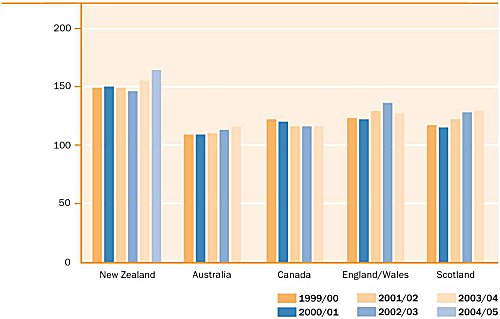
Imprisonment Rate
The imprisonment rate identifies the number of people imprisoned per 100,000 of the national population. This is an indication of the extent to which prison is used as a sentencing option by the judiciary.
New Zealand has the highest rate compared with other benchmarked jurisdictions. New Zealand has had the highest imprisonment rate of the five jurisdictions since 1997/98 and has continued to increase to a 2004/05 rate of 164 prisoners per 100,000 of national population. Canada has had a decreasing rate over the last five years while England/Wales and Australia show marginal increases. The Canadian data excludes those prisoners serving sentences of less than two years, who are not accommodated in federal institutions.
Reducing Re-offending
Progress towards the achievement of the departmental outcome of reducing re-offending is assessed through the use of two measures, the Recidivism Index (RI) and the Rehabilitation Quotient (RQ). Both measures use re-conviction data where the result is a sentence or order administered by the Department.
Recidivism Index
The Recidivism Index (RI) quantifies the rate of re-offending of a specified group of offenders over defined follow-up periods after release from a custodial sentence or commencement of a community-based sentence. The RI analysis gives re-conviction rates over 12 months for those released from prison, or who commenced a communitybased sentence, during the 2003/04 (1 April-31 March) year, and over 24 months for those released from prison, or commencing communitybased sentences, during the 2002/03 year. RIs are reported for all offenders in each of the above categories, as well as for sub-groups within categories. Disaggregated RI figures are reported according to the following dimensions: gender, ethnicity, age, offence type, offence seriousness, sentence type (CPS), security classification and release type (PPS), and sentence length. This year, for the first time, RI figures are also reported in relation to offenders' assessed risk of re-offending.
The RI analysis uses re-conviction information obtained from the Ministry of Justice's Case Management System (CMS) database. The date of the re-conviction data extraction (for both 12- and 24-month follow-up periods ending 31 March 2005) was 30 June 2005.
RI figures are produced for two potential outcomes: re-conviction leading to any sentence administered by the Department, and re-conviction leading to imprisonment. Imprisonment figures are perhaps the more critical of the two measures, as this outcome is associated with more serious offences and higher costs of sentence administration. However, the majority of re-convictions lead to non-custodial sentences, and general re-conviction figures generally provide a more complete measure of recidivism.
The RI figures exclude re-convictions that result in sentences not administered by the Department (for example, discharge following conviction, fines): such outcomes are usually associated with relatively minor offending that has little significance for public safety. As is also common internationally with measures of this type, the figures exclude re-convictions for administrative offences (for example, breaches of parole, failure to complete community work).
In developing the RI measure, along with other measures derived from its offender management processes, the Department has enabled comparisons to be made with correctional services in other countries. The current indicators provide a starting point for assessing the Department's performance, and will continue to be enhanced over time, in conjunction with other justice sector agencies. It should be noted, however, that the use of re-conviction data as indicators of Departmental performance is not straightforward: re-offending, re-conviction and sentencing are subject to a range of influences, many of which are outside the Department's direct control.
Changes to RI Computation
As noted in the 2003/04 Annual Report, the methodology used to generate the RI data was substantially changed from that used in earlier years. Use of the Department's data warehouse has enabled a higher level of precision and specificity to be applied to all aspects of the procedure, including the manner of dealing with individual records. This means that RI statistics for 2003/04 and 2004/05 may not be directly comparable to figures reported in prior years. In fact, the methodology has continued to undergo refinement in the last twelve months. While the refinements undoubtedly increase the level of accuracy of the latest figures, this caveat must be understood in comparing the results for the current and previous years.
When reporting RI figures by PPS release type, 2004/05 is likely to be the last year in which the reporting of RIs in relation to' discretionary' and 'non-discretionary' parole release is meaningful. Since the 1 July 2002 implementation of the Parole Act, all persons sentenced to more than two years imprisonment are subject to New Zealand Parole Board discretion, and thus only a small and dwindling number of releases are now 'nondiscretionary'.
Analysis of reported RI figures
Table 8 (page 38) provides re-conviction rates as recorded over 12 months, for those released from prison, or commencing community-based sentences, during the 2003/04 (1 April-31 March) year, and Table 9 (page 39) provides the rates over 24 months for those released from prison, or commencing community-based sentences, during the 2002/03 year. RI figures are reported for multiple categories of offenders, with significant variation observed in re-conviction rates between sentence types, offence types and demographic groups.
The overall RI results for 2004/05, when compared to the 2003/04 reported results, indicate a small percentage increase in average re-convictions and re-imprisonments for all offenders released from prison, but small decreases in re-conviction and imprisonment rates for offenders commencing community-based sentences.
RI Sub-group Comparisons
When examined by the sub-groupings for which RIs are calculated, notable features for those released from a custodial sentence (12-month followup) include the following:
- Males are re-imprisoned at a significantly higher rate than females (30% and 18% respectively) and re-conviction rates for male offenders released from prison are also higher than for female offenders (43% and 35% respectively).
- The re-imprisonment and re-conviction rates for Pacific peoples (18% and 28% respectively) were notably lower than those for Maori (32% and 47%) and Europeans (27% and 40%).
- Re-imprisonment rates reduce by approximately two-thirds as offenders age (offenders over 40 years are re-imprisoned at less than one-third the rate of those under 20), and vary markedly between offence classes (dishonesty offenders having the highest rates and sex offenders the lowest).
- Offenders released on home detention had re-conviction and re-imprisonment rates substantially lower than the average. This difference was particularly marked for those released from prison to 'back-end' home detention, with the re-imprisonment rate (10%) being lower than almost every other sub-group of released prisoners.
- Prisoners granted early release on parole ('discretionary' releases) were re-convicted at rates lower than those subject to other types of release (other than home detention); comparisons with the 2003/04 12-month RI figures for discretionary releases reveals almost a 5 percent reduction in re-convictions amongst this group.
- Re-imprisonment rates were higher for prisoners released from medium security classification (39% to 40%) than those for prisoners released from minimum security classification (25%).
- There is a tendency for shorter sentence length to be associated with higher rates of re-imprisonment and re-conviction: offenders serving sentences of between one and two years are re-imprisoned at a higher rate than offenders with a sentence length between three and five years (33% and 21% respectively); it is likely that older age (which bears a strong inverse relationship to risk) is linked to lower recidivism amongst longer-sentenced prisoners.
- For offence seriousness (the offence for which the person was originally convicted) a similar inverse relationship with rate of re-imprisonment and re-conviction appears: medium seriousness score (for example, dishonesty, burglary) offenders are re-imprisoned at a higher rate than offenders with a very high seriousness score (approximately 35% versus 27% respectively).
Offenders serving community-based sentences had significantly lower imprisonment and re-conviction rates than offenders released from prison. In general, most of the trends noted for released prisoners above were evident for this population also.
Of interest is the fact that, although 'front-end' home detention is typically applied to those whose risk of offending is higher than other offenders serving community-based sentences, these home detainees recorded a rate of imprisonment that was almost equivalent to those sentenced to Community Work, and somewhat lower than those serving supervision orders. The 2004/05 reported re-conviction and re-imprison-ment rates for home detainees (both front- and back-end) are lower than the corresponding figures reported in 2003/04; in the case of front-end re-convictions, the reduction is 2.5 percent. A similar decrease is apparent for offenders sentenced to community work.
For both prison releases and community sentence offenders, the 24-month RIs generally show a predictable pattern, in that the 24-month RI figures typically increase by between 35 percent to 50 percent over the 12-month rates. This is consistent with a great deal of research on recidivism which indicates that the highest rate of re-conviction occurs within the first twelve months, with the proportion re-convicted in each successive year progressively smaller than in the previous year.
RI and offender risk scores The Department has, since 2001, assessed each offender using a sophisticated computerised risk measurement procedure known as RoC*RoI (RoC refers to risk of re-conviction, RoI to risk of re-imprisonment). The process uses a range of variables1 relating to each individual offender to calculate a score which indicates the relative probability that the offender will be re-imprisoned within the following five years.
A RoC*RoI score of 0.55 indicates a 55 percent likelihood that the offender will be re-imprisoned within five years. The Department uses RoC*RoI scores within its sentence management procedures primarily to determine the prioritisation of offenders for key rehabilitative services.
For the first time since adopting this form of offender risk assessment, the Department is able to report actual recidivism rates in relation to the risk scores of offenders. Table 10 (page 40) contains the percentages of offenders within each risk score decile band who were re-convicted and/or re-imprisoned.
For example, the bottom row of the irst sub-table within Table 10 (headed '12 months follow-up') indicates that, of all offenders (i) with a risk score of 0.9 or greater and (ii) released from prison during the 1 April 2003 to 31 March 2004 period, 88.9 percent were re-convicted within that 12 months period, and 79.6 percent were re-imprisoned.
The risk scores used were calculated at release from prison or start of community-based sentence, so any subsequent re-conviction for an offender (as is reflected in the RI rates) did not contribute to that individual's risk score calculation. The resulting data shows a very high level of correlation between risk scores and the incidence of re-conviction or re-imprisonment within the 12- and 24-months follow-up periods. As such these results offer an important and compelling validation of the Department???s risk assessment methodology.
Re-conviction rates for both prison releases and community sentence offenders are very similar, but imprisonment rates are not. It appears that having been recently released from prison functions as a strong influence over the likelihood that, if convicted of a new offence, the sentence will be a further term of imprisonment.
Table 8: Recidivism Indes - 12-Month Follow-up (percentages) for 2003/04
|
Category |
Group |
Prison releases |
Community sentenced |
|||||||||||||||||||||||||||||||||||||
|
Re-imprisoned |
Re-convicted |
Imprisoned |
Re-convicted |
|||||||||||||||||||||||||||||||||||||
|
All |
|
28.9 |
42.6 |
8.0 |
29.2 |
|||||||||||||||||||||||||||||||||||
|
Gender |
|
|
|
|
|
|||||||||||||||||||||||||||||||||||
|
Ethnicity |
|
|
|
|
|
|||||||||||||||||||||||||||||||||||
|
Age (at PPS release or start of CPS sentence) |
|
|
|
|
|
|||||||||||||||||||||||||||||||||||
|
Offence (Most serious for original sentence) |
|
|
|
|
|
|||||||||||||||||||||||||||||||||||
|
Community-based Sentence |
|
|
|
|
|
|||||||||||||||||||||||||||||||||||
|
Prisoner Security Classification (at release) |
|
|
|
|
|
|||||||||||||||||||||||||||||||||||
|
Release Type |
|
|
|
|
|
|||||||||||||||||||||||||||||||||||
|
Sentence Length |
|
|
|
|
|
|||||||||||||||||||||||||||||||||||
|
Seriousness Score***** |
|
|
|
|
|
|||||||||||||||||||||||||||||||||||
|
All (2002/2003) |
|
28.0 |
42.3 |
8.6 |
34.0 |
|||||||||||||||||||||||||||||||||||
Table 9: Recidivism Indes - 12-Month Follow-up (percentages) for 2002/03
|
Category |
Group |
Prison releases |
Community sentenced |
|||||||||||||||||||||||||||||||||||||
|
Re-imprisoned |
Re-convicted |
Imprisoned |
Re-convicted |
|||||||||||||||||||||||||||||||||||||
|
All |
|
37.2 |
55.4 |
11.7 |
40.2 |
|||||||||||||||||||||||||||||||||||
|
Gender |
|
|
|
|
|
|||||||||||||||||||||||||||||||||||
|
Ethnicity |
|
|
|
|
|
|||||||||||||||||||||||||||||||||||
|
Age (at PPS release or start of CPS sentence) |
|
|
|
|
|
|||||||||||||||||||||||||||||||||||
|
Offence (Most serious for original sentence) |
|
|
|
|
|
|||||||||||||||||||||||||||||||||||
|
Community-based Sentence |
|
|
|
|
|
|||||||||||||||||||||||||||||||||||
|
Prisoner Security Classification (at release) |
|
|
|
|
|
|||||||||||||||||||||||||||||||||||
|
Release Type |
|
|
|
|
|
|||||||||||||||||||||||||||||||||||
|
Sentence Length |
|
|
|
|
|
|||||||||||||||||||||||||||||||||||
|
Seriousness Score***** |
|
|
|
|
|
|||||||||||||||||||||||||||||||||||
Notes for tables 8 and 9
The results highlight rates of re-conviction/re-imprisonment (within a subsequent 12-month period) amongst all offenders released from prison or commencing a new communitybased sentence between 1 April 2003 and 31 March 2004. The source is CMS conviction and sentencing data, as at 30 June 2005.
* The Sentencing Act 2002 abolished Periodic Detention and replaced it with Community Work on 1 July 2002
** Insufficient numbers to report RI for prisoners released with a security classification of 'maximum'
*** 'Front-end' Home Detention reported as CPS new starts, 'back-end' Home Detention reported as PPS releases
**** Post-release conditions were introduced by the Sentencing Act 2002; order imposed by judge at time of sentencing
***** Seriousness scores derived from the Ministry of Justice 'offence seriousness scale'.
Table 10: Recidivism Index by ROC*ROI (percentages)
|
12-months follow-up |
Prison releases |
Community sentenced |
|||||||||||||||||||||||||||||||||||||||||||||||||||||
|
Category |
Group |
Re-imprisoned |
Re-convicted |
Imprisoned |
Re-convicted |
||||||||||||||||||||||||||||||||||||||||||||||||||
|
All |
|
28.9 |
42.6 |
8.0 |
29.2 |
||||||||||||||||||||||||||||||||||||||||||||||||||
|
RoC*RoI (at PPS release or start of CPS sentence) |
|
|
|
|
|
||||||||||||||||||||||||||||||||||||||||||||||||||
|
24months follow-up |
Prison releases |
Community sentence |
|||||||||||||||||||||||||||||||||||||||||||||||||||||
|
Category |
Group |
Re-imprisoned |
Re-convicted |
Imprisoned |
Re-convicted |
||||||||||||||||||||||||||||||||||||||||||||||||||
|
All |
|
37.2 |
55.4 |
11.3 |
40.2 |
||||||||||||||||||||||||||||||||||||||||||||||||||
|
RoC*RoI (at PPS release or start of CPS sentence) |
|
|
|
|
|
||||||||||||||||||||||||||||||||||||||||||||||||||
The highest risk offenders are re-convicted quite rapidly. The risk procedure predicts the expected rates of re-imprisonment within five years, but the highest risk groups appear to be hitting that level of re-imprisonment within two years. The model thus appears to be under-predicting the probability of re-imprisonment. This may reflect changes to the criminal justice processes over the past ten years: for example, a higher police offence resolution rate currently than occurred in the time period (circa 1990) from which were drawn the offending history details which provided the basis for the risk assessment algorithm.
Rehabilitation Quotient
The Department routinely delivers a range of rehabilitative and reintegrative interventions designed to enable offenders to lead law-abiding lives. These programmes have been designed and implemented in ways consistent with internationallydeveloped 'best practice' principles.
Research on outcomes from rehabilitative programmes has shown that significant reductions in reconviction and re-imprisonment can be achieved when this form of intervention is effectively delivered to appropriately selected offenders.
The purpose of the Rehabilitation Quotient (RQ) is to gauge the extent to which re-offending is reduced amongst those who received a rehabilitative intervention. In order to accurately measure the impact of the intervention, each 'completer' is matched with one or more 'controls' who are similar on key variables such as age, gender, assessed risk of re-offending, type of sentence (prison versus community), sentence length and, in some cases, offence type. The length of the followup period (eg, after release from prison, and during which reconviction is possible) for both groups is equivalent. Any differences in reconviction rates can then be interpreted as an indication of the programme's impact.
As with RI (discussed above), the Department has re-developed the RQ methodology within its data warehouse. This change offers a higher degree of reliability in respect of the figures produced, as the automated procedures ensure that matching occurs with a high degree of accuracy, and that individual records are handled in a consistent and valid manner.
Programme data are reported for offenders from two periods. Twelvemonth follow-up data relate to offenders who completed a programme between 1 April 2003 and 31 March 2004. The 24-month follow-up data are for offenders who completed a programme between 1 April 2002 and 31 March 2003.
For both groups, reconviction and sentencing data relate to any new offences committed after programme completion, and up to 31 March 2005. This information was extracted from the Ministry of Justice Courts Management System (CMS) database on 30 June 2005.
The RQ statistic signifies the percentagepoint difference in re-conviction/re-imprisonment rates between offenders who completed individual programme types and matched 'untreated' offenders. A figure of 0.10 indicates that the reconviction rate of treated offenders is ten percentage points lower than the rate for controls (eg, if reconviction rates for treated offenders and matched controls were 15% and 25% respectively, the relevant RQ would be 0.10). A figure close to zero would indicate little or no difference in the reconviction rates between programme completers and controls.
International research in this area indicates that best practice, that is the most effective correctional programmes, can achieve only relatively modest reductions in re-convictions. The research generally shows that RQ-type scores of between 0.07 and 0.15 are attainable when adequate service delivery is targeted at appropriately selected offenders. Scores above 0.15 would be exceptional, and would generally only be expected from the most highly specialised and intensive of interventions.
Nevertheless, because of the high cost of crime even modest reductions can mean that those programmes are highly cost-effective. The Department is committed to ensuring that its rehabilitative programmes continue to develop to the point where they match, or exceed, the rates of reduced re-offending achieved elsewhere.
RQ data on intervention effectiveness produced this year are shown below in Tables 11 and 12. Results for only a proportion of the programmes delivered by the Department are presented. A number of programmes could not be included in the analysis because of inadequate sample sizes - low sample size can be a consequence of low starter rates or high noncompletion rates.
In addition to the results reported here, the Department applied the standard RQ analysis to its Straight Thinking programme. The results are not reported, as this programme is used primarily as a means of motivating offenders towards change (by agreeing to engage in a rehabilitative programme) rather than as a means of directly reducing re-offending.
Further, the RQ methodology meant that Straight Thinking results were derived solely from offenders who had not subsequently gone on to attend a rehabilitative programme (ie, data for those who had completed a subsequent rehabilitative programme were incorporated within the analysis of that rehabilitative programme). The preliminary analysis of Straight Thinking shows some negative results. More detailed analysis is required before it is possible to assess the true impact of Straight Thinking on re-offending - particularly when it is delivered as a motivator for other more intensive programmes.
Tables 11 and 12 show that most of the results are close to zero, reflecting no apparent impact of programmes on re-offending. Only one of the results reaches a level of statistical significance.
Positive results were recorded in relation to one sub-group of programmes, mainly the three prisonbased drug and alcohol special treatment units (STUs), and the sex offender STUs operated by the Department???s Psychological Service. Negative results were recorded in relation to the 100-hour programmes. Closer analysis indicates that this effect may be concentrated on particular sub-groups of offenders. This is also in line with emerging international literature in this area, and suggests the need for further work on the targeting of these programmes. Further analysis will continue to be undertaken, and more comprehensive results will be reported next year.
Lack of statistical significance can be a result of small sample sizes. This problem can be overcome by combining data from multiple years (for a single programme type), or by combining data from similar programme types (eg, all 100-hour programmes) within a single year. Preliminary indications are that, when these methods were used, significantly positive results were obtained in relation to two sub-groups of programmes: the prison-based drug and alcohol STUs, and the sex offender STUs operated by the Department's Psychological Service. This finding is in accordance with more detailed evaluations previously published in relation to these programmes.
A further caveat on the interpretation of these results is that offenders managed by the Department have access to a wide range of services, including educational, employment and general living skills training, as well as various supports to assist with reintegration to the community. These services are available in varying degrees to offenders irrespective of whether they have also participated in the core rehabilitative interventions (the impact of which the RQ attempts to measure). At this stage the RQ methodology does not ascertain the nature and quality of these services as accessed by individuals, and does not take into account the relative contribution that each of these services may be making to final recidivism outcomes. However, it is widely accepted that the provision of education, training and reintegrative support services can have a significant impact on re-offending.
The Department is further strengthening its sentence management framework. The delivery structures for many of the Department's programmes (particularly the 100-hour programmes) are still in a developmental phase. The re-organisation of programme delivery services resulted in the establishment of Intervention Services in 2004. The Department is also seeking to improve facilitator training and skill development, their supervision, and general programme integrity.
|
Intervention Type |
Prison Programmes |
Community Programmes |
||
|
Reconvicted |
(Re-) Imprisoned |
Reconvicted |
(Re-) Imprisoned |
|
|
Special Treatment Units (sex offending) |
n/a |
n/a |
- |
- |
|
Special Treatment Units (alcohol & drugs) |
0.16 |
0.10 |
- |
- |
|
100-hr Alcohol & Drugs Programme |
???0.04 |
0.05 |
0.17 |
0.08 |
|
100-hr Generic Programme (M-PRO) |
n/a |
n/a |
???0.15 |
???0.07 |
|
100-hr Driver Offender Programme (MODS) |
- |
- |
0.06 |
0.04 |
|
Structured Individual Programme (SIP) |
- |
- |
n/a |
n/a |
|
Community-funded violence programmes |
- |
- |
0.05 |
0.02 |
|
Community-funded alcohol & drugs programmes |
- |
- |
0.11 |
0.05 |
Note 1: Figures represent percentage-point differences between recidivism rates for treatment and control groups. Positive scores indicate a reduction in re-conviction/re-imprisonment for treated offenders (eg, 0.10 indicates that the rate of reconviction/re-imprisonment among treated offenders was 10 percentage points lower than the rate for untreated offenders).
Note 2: 'n/a' indicates that an RQ could not be calculated because the number of programme completers was insufficient; cells marked with a dash (-) indicate that the programme type is not delivered in that (prison or community) setting.
|
Intervention Type |
Prison Programmes |
Community Programmes |
||
|
Reconvicted |
(Re-) Imprisoned |
Reconvicted |
(Re-) Imprisoned |
|
|
Special Treatment Units (sex offending) |
0.03 |
0.08 |
- |
- |
|
Special Treatment Units (alcohol & drugs) |
0.10 |
0.11 |
- |
- |
|
100-hr Alcohol & Drugs Programme |
-0.05 |
-0.01 |
-0.11 |
-0.08 |
|
100-hr Generic Programme (M-PRO) |
-0.04 |
-0.06 |
-0.09* |
-0.04* |
|
100-hr Driver Offender Programme (MODS) |
- |
- |
??? |
0.00 |
|
Structured Individual Programme (SIP) |
- |
- |
-0.04 |
-0.02 |
|
Community-funded violence programmes |
- |
- |
0.01 |
0.02 |
|
Community-funded alcohol & drugs programmes |
- |
- |
-0.03 |
-0.02 |
Note 1: Figures represent percentage-point differences between recidivism rates for treatment and control groups. Positive scores indicate a reduction in re-conviction/re-imprisonment for treated offenders (eg, 0.10 indicates that the rate of reconviction/re-imprisonment among treated offenders was 10 percentage points lower than the rate for untreated offenders).
Note 2: An asterisk (*) indicates that the result is statistically significant.
Alternative Outputs Analysis
During the course of 2003/04, the Department closely examined the issue of intergenerational transmission of criminality: the processes that underlie the widely recognised phenomenon that the children of offenders have a very high risk of becoming offenders themselves. While useful analysis was completed, the Department concluded that it could not feasibly deliver effective interventions in this area, and therefore has sought to champion this issue in work undertaken by other agencies with a clearer mandate for such interventions.
In the same year, the Department considered prison design and staffing models that differed to the current preferred model. The outcome of the process was that the Department was satisfied that its present approach was entirely justified on fiscal, operational and rehabilitative grounds.
The Department is developing a cost/benefit model to assist with the evaluation of its rehabilitative programmes. With RQ data available for specific programmes, the development and implementation of the model will provide greater visibility of the actual and projected costs and benefits associated with rehabilitative programmes, and provide data to inform decisions about optimising the prioritisation of those programmes.
Evaluation, Research and Monitoring
The Department is committed to the development of evidence-based interventions that can be implemented successfully to assist with the achievement of outcomes. As part of this approach, the Department operates an active research and evaluation programme. The programme encompasses research on new interventions, assessment of the relevance of overseas approaches in the New Zealand context, and evaluations of the performance of specific interventions.
Projects, including some multi-year projects, progressed during the 2004/05 financial year, were:
- study into the treatment of noncompletions and factors associated with participant drop-out from rehabilitative programmes, and strategies to intervene to promote programme completion
- development of a criminogenic (100-hour) programme for women offenders
- evaluation of the violence prevention unit
- investigation of the characteristics and needs of sex offenders against adults
- investigation of the characteristics and needs of very high-risk offenders.
1 Variables used in calculation of individual risk scores include current age, gender, age at first conviction, number and seriousness of convictions, number and type of previous sentences, and amount of time spent in custodial sentences.

